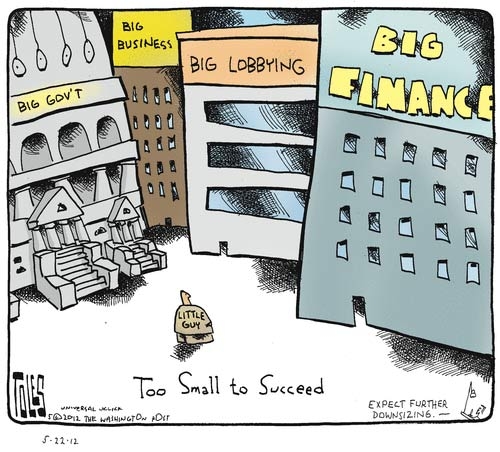
According to the old joke, an 800-pound gorilla sleeps anywhere it wants to. When it comes to the expansion of Too Big To Fail institutions in this country, we now have more than one 800-pound gorilla in the room, and all of them have been gaining weight rapidly since 2007. Far from being tamed in their appetites and slimmed down in their corpulence by remedial legislation, these institutions have been engaged in a financial binge of almost breathless proportions.
To learn more about the five largest financial institutions and their effect on the US Financial System checkout the infographic below created by New Jersey Institute of Technology.

NJIT New Jersey Institute of Technology – Online MBA
In previous crises, there was always a price paid for rescuing depositors. The 1984 failure of the country’s seventh-largest bank, Continental Illinois, forced the government to step in and guarantee depositors in full. The bank was finally absorbed by Bank of America in 1994, but the bank’s shareholders and management were not around to rejoice in its eventual rescue.
The same factors applied to the Savings and Loan industry collapse in the mid-1980s. Although the individual banks were not too big to fail, the industry as a whole seemed to be, yet it was liquidated in total and its assets disposed of.
Reaching the Limits of Failure
The decisive point in the whole Too Big to Fail problem came via the collapse of Lehman Brothers in 2008. While Lehman itself was in fact allowed to fail, the consequences proved so dire that governments worldwide scrambled to contain the damage rippling out of its ruined business model. It was this experience that crystalized the whole TBTF problem. Lehman had been just barely not too big to fail, but a second firm of its approximate size or one of the true giants of the financial industry would indeed involve a bankruptcy too costly to contemplate.
The outcome of this experience was the so-called Dodd-Frank bill of 2010, which laid out procedures for winding down financially significant firms and placed a variety of regulatory restrictions on their activities. Dodd-Frank contains many provisions that would make banks less anxious to require rescue– such as changes in management, the ability to hold shareholders responsible, and sweeping powers to seize or otherwise wind up the affairs of any firm that falls into the TBTF category.
Truth or Dare
The big problem with the law, however, is that there is a widespread belief the government will not stick to its guns when the time comes to really execute it. Until the day comes when it truly happens, there will always be a sneaking belief that the law is a mere sop to the voters rather than a serious policy proposal.
Another difficulty lies in the shadowy provision that government intervention in these rescue operations be paid for with private funds. Whatever the intent of the law may have been, the net effect is to raise the specter of a Cyprus-style bail-in wherein the unfortunate depositors find themselves stripped of their money and left with shares in a now-worthless financial institution.
A follow-on law, the Brown-Vitter Act of 2013, lays down a series of capital requirements which TBTF institutions are required to meet. While this sounds good on paper, the sheer mathematics of any fractional banking system means that there is no possibility of reserve requirements being able to meet even the smallest fraction of institutional needs in a real emergency.
Of potentially more use might be the modified and resurrected 21st Century Glass-Steagall Act of 2014, but this remains a proposal rather than a law, and may prove to be a mere shell compared to the original ironclad Act of 1933. Regardless of the efficacy of any of these proposals, however, the raw fact remains that the 800 pound gorillas of the TBTF category continue to grow larger– more than 40% larger in just the past five years and have control over more than 2/3rds of the nation’s overall banking assets.
Where We Stand Today
Legislation continues to lag TBTF growth and the public suffers from an increasing lack of faith that these institutions will ever be reined back in again. Surveys reveal the belief that government is more the captive than the master of these institutions, and their interests are being furthered at the expense of the suffering public.
Governments might point to the more than 20 billion dollars in fines and penalties imposed on just a single TBTF player, JP Morgan Chase, in the single year of 2013 as proof that their reforms are working. However, the public is more likely to note the massive level of abuse that would warrant 20 billion in fines, as well as the probability that only a portion of the financial rapacity was ever uncovered.
Matching Opportunity Extended: Please support Truthout today!
Our end-of-year fundraiser is over, but our donation matching opportunity has been extended! Today, all donations to Truthout will be matched dollar for dollar. Your one-time gift today will be matched immediately. As well, your monthly donation will be matched for the whole first year, doubling your impact.
This matching gift comes at a critical time. Trump has made it no secret that he is planning a demolition-style attack on both specific communities and democracy as a whole, beginning on his first day in office.
Help us prepare for Trump’s Day One, and have your donation matched today!